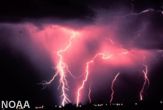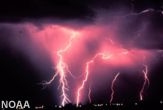Avoidable Lightning Deaths Mount in 2005

Lightning has killed at least 14 people and injured more than 100 in the United States since early June, according to a statement issued today by NOAA, parent organization of the National Weather Service.
The statistics were based on reports from local Weather Service offices and news accounts.
An average of 67 people are killed by lightning each year in the United States. July is typically the worst month.
Last weekend, lightning killed a worker at a mobile home park in Grayson, Ky., and a father and his step-son at the beach in Gulf Shores, Ala. Another 16 people were injured by lightning in Florida, North Carolina and Wisconsin.
Many of the deaths are avoidable, officials say.
"Too often, people wait too long before seeking safe shelter from a thunderstorm and find themselves caught outside in a very dangerous and sometimes deadly situation," said John Jensenius, a lightning safety expert with the NOAA National Weather Service.
"If you can hear thunder, you're likely within striking distance and need to get to a safe place immediately," Jensenius said. "If you're outside, you also should keep a watchful eye on the sky for developing thunderstorms, especially if background noise interferes with your ability to hear thunder."
Get the world’s most fascinating discoveries delivered straight to your inbox.
A substantial building is the safest place to be. A hard-topped metal vehicle is a good second choice, NOAA advises. Inside, avoid contact with any electrical equipment or plumbing, stay off corded phones and stay away from windows and doors.
Some places seem like obvious bad ideas.
Last week, lightning struck a metal canopy and injured 21 soldiers who were standing under it at a National Guard facility in Pennsylvania.
The risk of lighting lasts longer than many people realize. Experts advise staying indoors for 30 minutes after a thunderstorm appears to have passed. Lightning often strikes as far as 10 miles away from any rainfall, scientists say. It can travel sideways and strike under blue skies.
Lightning is the second most frequent weather-related killer in the United States, trailing only flooding.
The Electric Earth

Image Gallery

The Science

